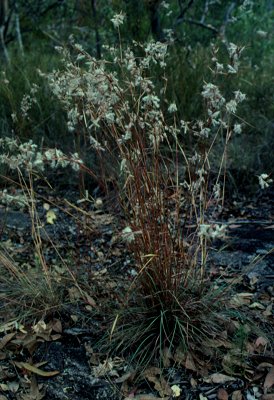 |
 |
|
 |
 |
|

Cymbopogon obtectus S.T.Blake |
Common name
Silkyheads
Derivation
Cymbopogon Spreng., Pl. Min. Cogn. Pug. 2: 14 (1815); from the Greek kumbe
(boat) and pogon (beard), alluding to the boat-shaped spatheoles subtending
the hairy racemes.
obtectus- from the Latin obtego (conceal). Segregated from a closely related species.
Published in
Univ. Queensland Dept. Biol. Pap. 2(3): 55 (1944).
Habit
Perennial, tufted. Basal leaf sheaths pubescent, persistent and investing base of culm. Culms 50–100 cm tall, 1–2-noded. Mid-culm nodes glabrous or pubescent. Ligule an eciliate membrane, 3–5 mm long. Leaf-blades flat or conduplicate or revolute, 15–35 cm long, 1–3 mm wide, aromatic. Leaf-blade margins scaberulous. Leaf-blade apex attenuate.
Inflorescence
Inflorescences arranged within a synflorescence.
Inflorescence terminal and axillary, subtended by a spatheole, enclosed.
Spatheole 2–3.2 cm long, herbaceous. Peduncle 0.5–1 cm long. Rames
paired, deflexed, 1.5–2.5 mm wide. Central inflorescence axis 7–25 cm
long. Rhachis fragile at the nodes, semiterete, villous on surface, villous on
margins. Rhachis hairs 4.5–7 mm long. Rame internodes linear, 2.75–4
mm long. Rame internode tip transverse, cupiliform. Rame-bases flattened,
subequal.
Spikelets
Spikelets in pairs, one sessile and fertile and the other (companion) spikelet
pedicelled. Pedicels linear, semiterete, 2.75–4 mm long, villous on surface,
with 4.5–7 mm long hairs. Basal sterile spikelets well-developed, 2 in
lower raceme, 0 in upper racemes, sessile and pedicelled. Basal sterile spikelet
pedicels free, linear. Basal sterile spikelets barren (lacking florets), equalling
fertile. Companion spikelets developed, sterile, comprising 2 unequal glumes
without lemmas or containing empty lemmas, lanceolate or ovate, 3–5 mm
long, shorter than fertile, deciduous with the fertile. Companion spikelet glumes
chartaceous, 11–13-nerved, glabrous, acute, muticous. Companion spikelet
lemmas 2, enclosed by glumes. Fertile spikelets 2-flowered, comprising 1 fertile
floret, lower floret sterile, upper fertile, without rhachilla extension, lanceolate
or elliptic or oblong or obovate, dorsally compressed, acute, 5–6.4 mm
long, 1–1.2 mm wide, falling entire, deciduous with accessory branch structures.
Spikelet callus bearded, base obtuse, inserted. Spikelet callus hairs 4–5
mm long.
Glumes
Glumes dissimilar, firmer than fertile lemma. Lower glume lanceolate, 100%
of length of spikelet, chartaceous, 2-keeled, keeled laterally, wingless, 0–5-nerved.
Lower glume intercarinal nerves distinct, 2–5 in number. Lower glume surface
concave. Lower glume surface impressed below. Lower glume apex acuminate. Upper
glume lanceolate, 1-keeled, 5–7-nerved. Upper glume margins ciliolate.
Upper glume apex acute.
Florets
Basal sterile florets 1, without significant palea. Lemma of lower sterile floret
lanceolate or oblong or ovate, 3.7–4.5 mm long, hyaline, 2–3-nerved,
ciliolate on margins, acute. Fertile lemma lanceolate, 3.6–4.5 mm long,
hyaline, 1–3-nerved. Lemma apex lobed, 2-fid, incised 15–33% of
lemma length, 1-awned. Median (principal) awn from a sinus, straight or geniculate,
6–8 mm long overall, without a column or with a straight or slightly twisted
column. Column glabrous. Palea absent or minute. Anthers 3, 1.7–2 mm long.
Grain with adherent pericarp, orbicular.
Continental Distribution:
Australasia.
Australian Distribution:
Western Australia, Northern Territory, South Australia, Queensland, New South
Wales, Victoria.
Western Australia: Fitzgerald, Hall, Dampier, Canning, Carnegie, Giles, Fortescue, Ashburton, Carnarvon, Austin, Irwin, Drummond, Dale, Eyre, Roe, Avon, Coolgardie. Northern Territory: Victoria River, Barkly Tableland, Central Australia North, Central Australia South. South Australia: North-western, Lake Eyre, Gairdner-Torrens Basin, Flinders Ranges, Eastern, Eyre Peninsula, Northern Lofty, Murray, Southern Lofty. Queensland: Cook, Burke, North Kennedy, South Kennedy, Port Curtis, Leichhardt, Burnett, Darling Downs, Moreton, Gregory North, Gregory South, Mitchell, Warrego, Maranoa. New South Wales: North Coast, Northern Tablelands, North-Western Slopes, Central-Western Slopes, North-Western Plains, South-Western Plains, North Far Western Plains. Victoria: Murray Mallee, Riverina.
Classification. (GPWG
2001):
Panicoideae: Andropogoneae
Notes
Endemic. A species occurring in drier regions of Australia. Flowers all year.

Habit (photo)
© K. Sparshott